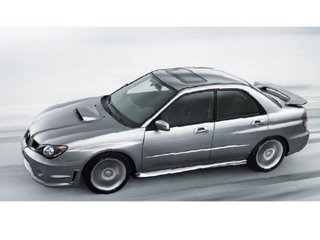Safety Features in the 2006 Subaru WRX STI Car
 Safety starts with symmetrical AWD
Safety starts with symmetrical AWDActive safety begins with the Subaru symmetrical full-time All-Wheel Drive system, which offers sure-footed traction and control in a variety of road and weather conditions. From snow-covered back roads to rain-sticked highways. The 2006 Impreza car gives drivers the confidence of being backed by more than 30 years of Subaru AWD expertise. The Subaru symmetrical full-time All-Wheel Drive system also provides the Impreza with the rock-solid stability to confidently carve through winding roads and sharp corners or blaze its own trail through rougher terrain. Because the Impreza's symmetreical All-Wheel Drive system is full-time, its benefits can be appreciated throughout every journey - even on dry, pristine roads.
Braking
In addition to the active safety benefits of the Subaru symmetrical full-time All-Wheel Drive system and the car's superb chassis, a 4-wheel/4-channel/4-sensor Anti-Lock Braking System (ABS) is also standard on all 2006 Impreza models. Working through sensors at all four wheels. ABS prevents wheels from locking up during heavy braking, allowing the driver to apply the brakes and steer away from trouble at the same time. ABS provides outstanding safety and control, even during emergency manoeuvres or in inclement wether conditions.
They are also equipped with Electronic Brake-Force Distribution (EBD), which detects passenger and cargo load and then controls the balance between front and rear brakes to help distribute brake force more effectively when the vechicle is weighed down.
Beyond the braking performance offerd by its ABS and EBD systems, This 2006 Impreza WRX STI models also boast new 4-piston calipers and 292 x 24 mm ventilated discs up front as well as 2-piston calipers and 288 x 18mm ventilated discs in the rear.
In the 2006 Impreza WRX STI, active safety is augmented by huge ventilated performance Brembo brakes with a Super Sport 4-wheel/4-channel/5 sensor Anti-lock Braking System (ABS). The Super Sport system is aided by a g-load sensore, which helps to make sure that braking forces are distributed effectively during cornering while braking - which makes it ideal for both accident avoidance maneuvres and high-performance driving.
Airbags, seatbelts and passive safety head restraints
All 2006 Impreza WRX STI feature dual front side-impact airbags as well as dual "smart" front airbags governed by a sophisticated system that detects passenger weight seatbelt use and driver seat position before deploying the airbags accordingly. In the event of a rear-end collision, both driver and front passenger seats on the car feature passive safety head restraints, which move forward automatically to cradle the head and neck, lessening the risk of whiplash. The front seatbelts feature pretensioners and load limiters while an ISO-FIX LATCH child seat anchor system and a trio of three-point seatbelts and head restraints come standard in the rear.
Ring-shaped reinforcement frame
In the event of an accident, Subaru's exceptional passive safety technologies help to offer a 360-degree barrierof protection. The 2006 Impreza's ring-shaped reinforcement frame has been designed to provide best-in-class collision safety. The Impreza also features energy-absorbing crumple zones, side-impact door beams and has earned the highest possible rating in frontal offset crash tests conducted by the Insurance Institute for Highway Safety.
Pedestrian protection
Thanks to energy-absorbing front bumpers and innovative wipers that break away when subjected to enough force, the 2006 Impreza not only protects its driver and occupants, but also those outside the car. The Impreza's WRX STI hood is also designed to minimize pedestrian injury in the event of a collision. Due to the distance between the hood and the compact SUBARU BOXER engine, pedestrains are less likely to come into contact with the engine in the event of collision.
Comments